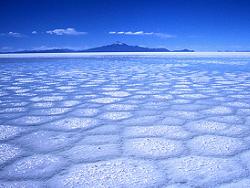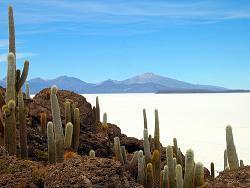 |
||||||
|
Enjoy This Site?
Then why not use the button below, to add us to your social networking site or your favorite bookmarking service? |
Salar de Uyuni
Salar de Uyuni is the world's largest and highest salt desert in the world sitting at an altitude of 3,650 meters (11,975 feet) above sea level. To get there one must travel to a small town called Uyuni in southwest Bolivia, which is near the border of Chile. Uyuni is the starting point to see this amazing salt desert that covers 4,200 square miles (11,000 square km). Which is about 25 times bigger than the Salt Flats in Utah. It is believed that about 25,000 years ago, the area was part of a giant prehistoric called Lake Minchin and that the lake covered much of southwest Bolivia. Eventually, the lake dried up and left behind a huge salt desert known as Salar de Uyuni. The Salar is said to be formed when the last waters from the lake evaporated, leaving behind salt that eventually deposited into the lowest lying part in that region and being leached by rain from the surrounding mountains. You'll see sights that seem like from another planet. Sights of unusual rock formations, red mountains, geysers, hot springs, volcanoes, giant cacti, red and green lakes. You'll also find wildlife such as many flamingos, llamas, vicuña (llama relative), and strange looking rabbits. A trip to this remote corner of Bolivia would not be complete without continuing to see two of Bolivia's natural wonders, the fiery red Laguna Colorada and the the greenish-blue colored Laguna Verde. These spectacular lakes lie about 350km (215 miles) southwest of Uyuni, across a desert landscape and over rugged dirt tracks. Most Interesting Sights
WeatherSince Salar de Uyuni is basically a desert, the weather conditions in the region can get extreme, from hot fierce sun during the day and to freezing night temperatures.Temperatures in the Uyuni region typically average 20°C (68°F) for highs during the day, but during the night it can dip well below freezing and the wind chill can add to the cold. Also, it is not uncommon for temperatures in the Salar de Uyuni to reach 30°C (86°F) during the day and fall to -25°C (-13°F) the following night. November through March is summer and warmer, but sees the most amount of rainfall and the salt flats will typically be covered in shallow water. As far as weather, the best months to visit Uyuni are between June and October, after the worst of the winter chills and before the summer rains. At any time of year you'll need protection against sun, wind and cold. Things to BringUyuni sits at an altitude of about 12,000 feet (3,650 meters.) You should bring warm clothing no matter what time of year you go because of the altitude. Also, the route to Uyuni is cold, some buses going there may not have very good heat. The salt flats have high solar radiation due to its altitude and the air is dry. It is good idea to bring extra water. Here is a list of recommended things that would be a good idea to bring:Interesting TriviaOther Related Pages:
|
|||||



